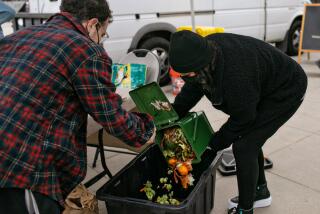Around the Yard
- Share via
Things to do this week:
* Save leaves. Don’t throw those falling leaves in the trash or even into those green waste barrels. Use leaves for mulch in flower beds, where they will protect the soil by blunting the force of raindrops and will keep mud from splashing on small plants. Or, hoard them in compost piles so they can be recycled into your own garden as mulch or amendment. Even eucalyptus leaves can be used, according to tests conducted by the University of California Cooperative Extension, Ventura County. Only hard leaves like those from evergreen magnolias are problematic (unless they are shredded or chopped up).
To create a compost heap, simply pile the leaves, preferably on dirt. It may take awhile for them to break down into compost, but winter storms will help keep them moist. Six months to a year later the compost will be ready to use.
* Plant more vegetables. The secret of a useful vegetable patch is to keep the veggies coming. Rather than one big harvest, you want almost daily small harvests so the cook is always supplied with fresh vegetables. The way to do this is to make frequent sowings or plantings, but not to put in too much at one time. Plant a few feet of carrot seed, then wait two weeks and plant a few feet more; plant a little lettuce and then plant some more a couple of weeks later.
Renee’s Gardens (in seed racks at nurseries) packages an “All Season Blend” of broccoli, a mix of varieties that ripen “early,” or quickly, and those that take longer--another way to spread out the harvest.
Other vegetables to plant now include beets, Brussels sprouts, cabbage, carrots, cauliflower, celery, endive, garlic, kale, kohlrabi, leeks, lettuce, mesclun mixes, onions, peas, radishes, spinach, Swiss chard and turnips.






